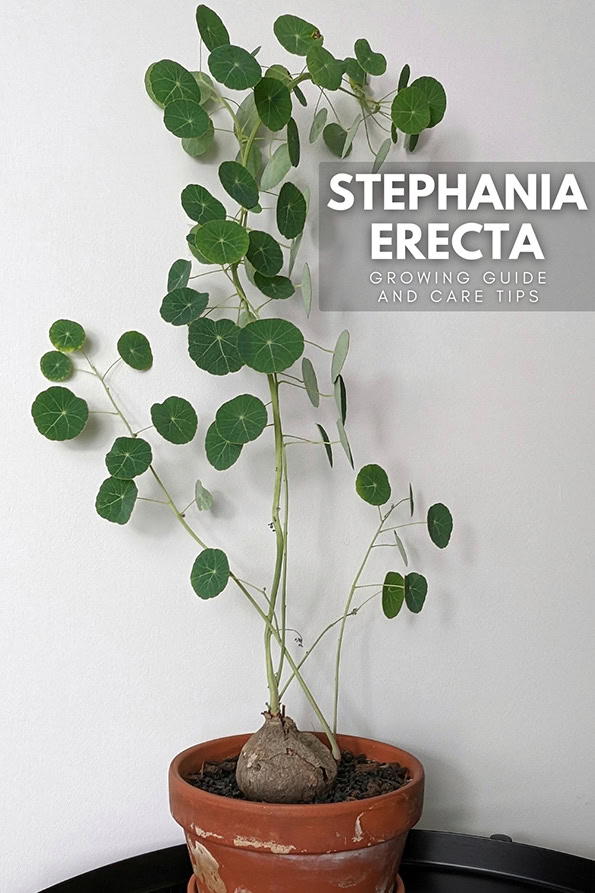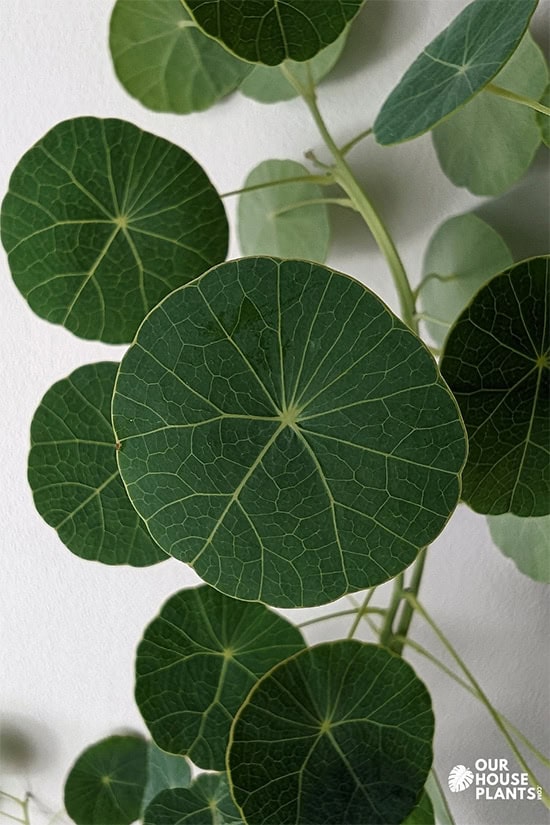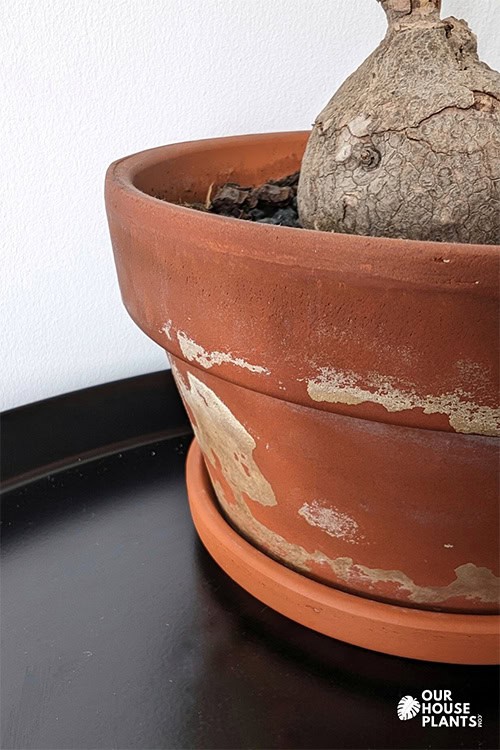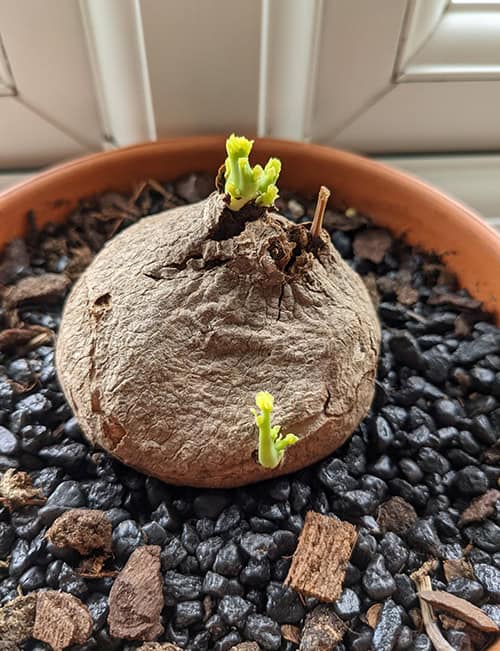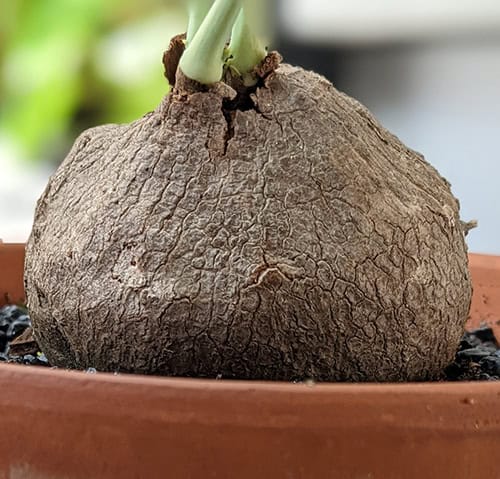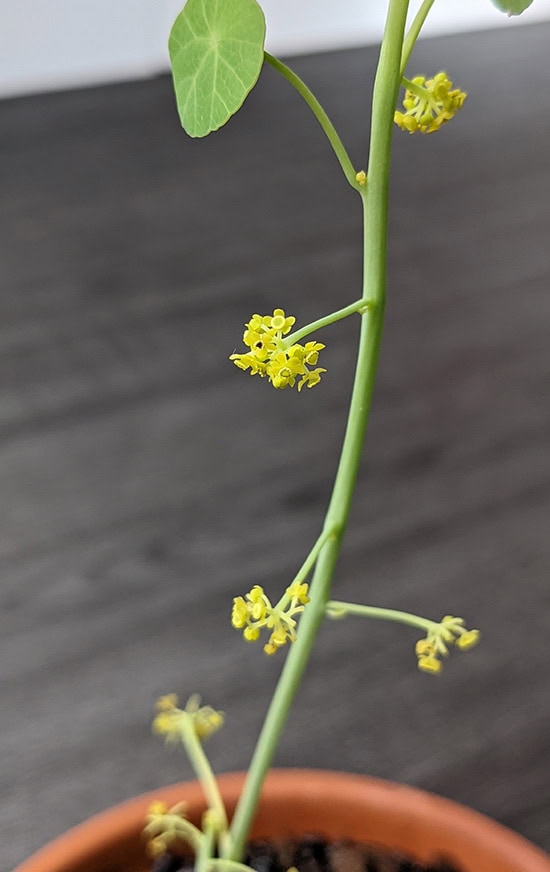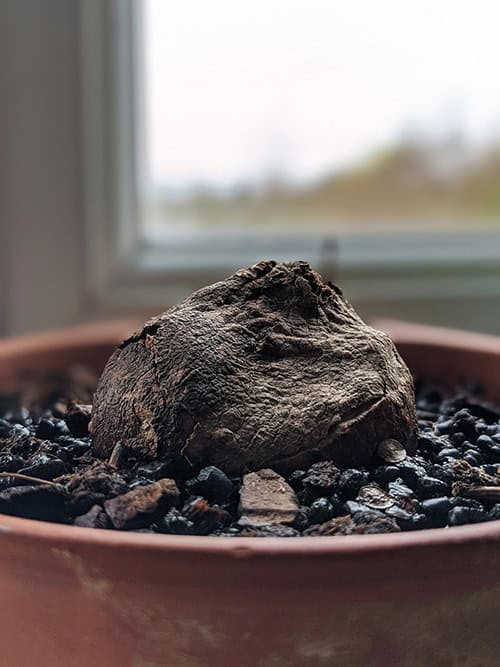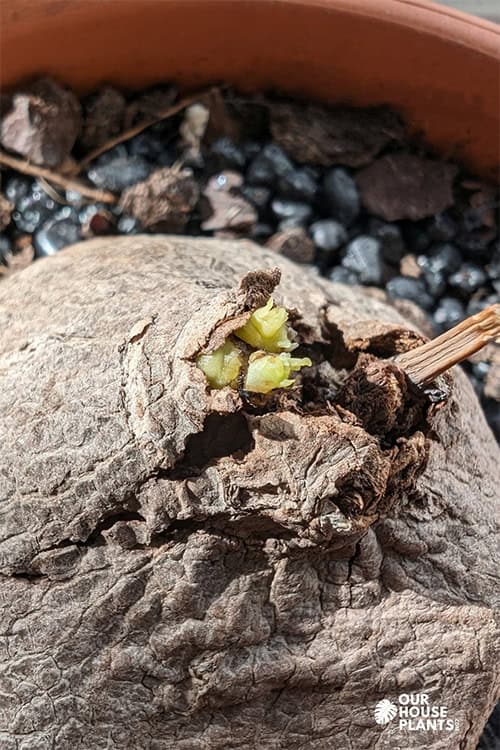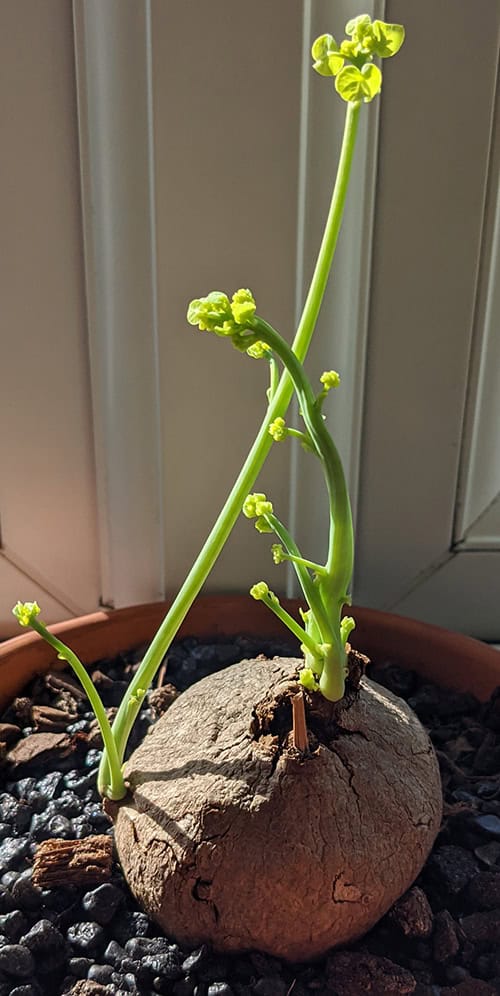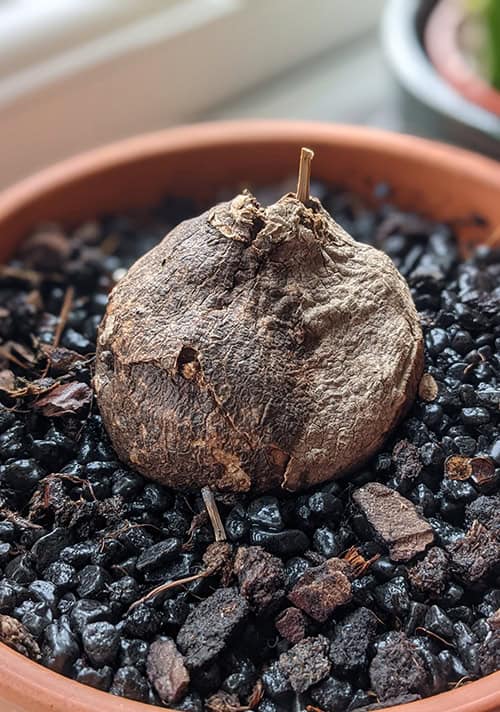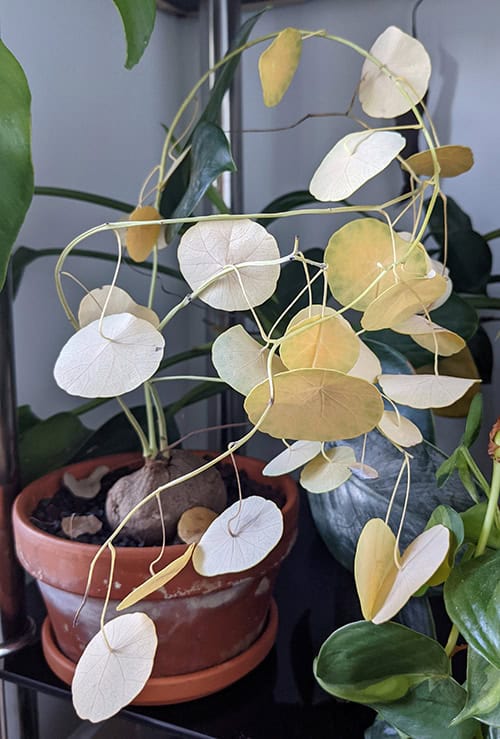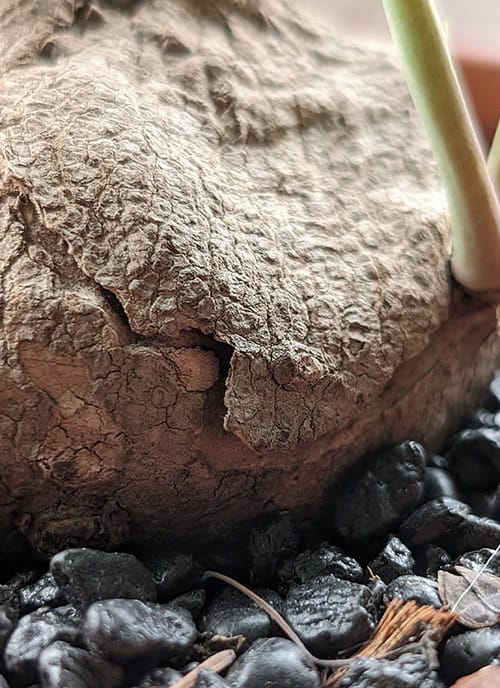Stephania erecta is a unique plant that became popular during the recent houseplant trend.
It has a round, bulbous caudex resembling a small rock or potato. Provide the right conditions and vines will sprout. Before long, delicate leaves with beautiful contrasting veining will grow from the stems.
The plant is reasonably straight forward to grow. It has an unusual dormancy stage that owners need to adjust to, but otherwise it has general care needs that are similar to many houseplants. Provided you've had some successful houseplant growing experience, the Stephania erecta shouldn't give you too much trouble.
Stephania erecta sometimes goes by the name Stephania pierrei. An unusual houseplant that sprouts vines from a potato like caudex. The foliage that follows, has intricate veining on the flat circular leaves.
Strictly speaking they're not rare houseplants, but they're not sold in many places due to supply issues and ongoing concern from ethical sellers who do not want to stock them due to a major poaching problem (more on that shortly).
How do you pronounce Stephania erecta correctly? Say:
Steh-FAH-nee-uh Ee-REK-tuh
There is only one variety of Stephania erecta, although there is an unusual variegated version too. However every plant tends to have a unique growth habit. Some will produce multiple stems with many leaves, others perhaps just a single stem with a handful of leaves.
Commercial nurseries will typically grow houseplants directly in large numbers when demand for a certain one starts up (this takes a while to get going and is the main reason "new" houseplants are initially expensive). This means almost all houseplants we buy come from cultivation rather than the wild.
Stephania erecta is different. I can't give you exact numbers here, but all the information I find on the topic suggests at least 90% of the plants that are sold have been stolen or "poached" from the wild.
The Lilly pad like leaves grow spirally around the stem with each leaf being higher than the last, like a staircase in a castle tower. The leaf petiole attaches near the center of the leaf, which from the front shows up as a large dot. Veins spread out from this central point.
Stephania erecta comes from Thailand, often growing in forests rich in limestone. It's a reasonably abundant plant, some locals even consider it to be a weed, according to Steef van Adrichem, a Director at the commercial plant nursery, Ansu who has looked into the issue.
But that doesn't make it okay to strip a plant from its natural habitat and the long term consequences on the local ecosystems are unknown. They grow so slowly and the large numbers that have already been taken, mean it will be decades or longer before the population is replenished.
This is similar to other houseplants like the Marimo Moss Ball. Although for them, their numbers in the wild are well recognized to be on the decline, and they've already become a protected species in parts of the world.
My three main thoughts about this issue.
1 -
If you brought a Stephania erecta and didn't know about the poaching issue. Don't beat yourself up about it.
2 -
Let's not further glamorize these plants until the horticultural industry sorts itself out and moves to 100% seed grown plants.
3 - Care for your Stephania erecta with purpose. Do not provide poor care. If you tire of it in your collection find it a new home rather than throwing it out. If you lose your plant, don't buy another one.
Keeping and cultivating houseplants is a fantastic hobby, but it's irresponsible to cause this type of destruction for a pastime.
I brought my plant a few years back from a popular and established plant shop on the high street. I vaguely knew a little about the poaching potential so I asked questions before buying. I was reassured by the owner he had visited the commercial nurseries in Holland who supplied his plants. They were seed grown and not poached.
After I brought it, I looked into the issue in much more detail and now suspect even mine is poached.
The caudex of a Stephania erecta, sometimes referred to as a "bulb". However it's actually a modified stem and not a true bulb.
There is no way to be certain but here are a few strong indicators that you have a poached plant.
I've owned my Stephania erecta for a number of years and I've debated putting together an article for a long time. This was mainly for fear of influencing more people into buying one.
However although I've been running Ourhouseplants for well over a decade I feel my Social Media influencer potential is limited. If you're reading this article it's more likely you've found it in order to learn about the care for this plant or you have a problem with it. I'm much less likely to have "influenced" you to buy one.
My primary goal with this site has always been to share my knowledge and experiences of growing different houseplants and hopefully give my readers pointers along the way. By writing a care guide for Stephania erecta I'm doing that and it will hopefully assist current owners in keeping their plants healthy.

Hi, I'm Tom!
If you're like me and enjoy the challenge of growing houseplants and getting them to thrive, then Ourhouseplants can help. This website shares my knowledge and years of growing plants and provides (hopefully) helpful advice on properly caring for your indoor plant friends.
Some full sun, either early morning or late afternoon is preferred. They will cope with a few different light conditions if needed. Bright indirect light or upper medium light levels can work too.
However you need to be careful. If the light levels are too bright the foliage can burn. If the light levels are too low you'll get long vines with large gaps between leaves. It will also weaken your plant every year you continue to grow it like this.
If you want a healthy plant that produces masses of foliage and several shoots rather than just one year after year, then you need to provide it with good light. This allows it to build up strength, so once it wakes up from dormancy the following year it has sufficient energy to grow well.
The right light levels are one of the keys to a healthy plant with multiple growth points.
If your plant is entering dormancy or is already there, the light levels are much less critical. You can store the caudex in a darker spot if required. Make sure you bring it back into the light when new growth sprouts.
Watering the Caudex
The roots on these plants are often very superficial. So watering around the caudex might not be effective. You can gently and slowly water the caudex itself. This will trickle around and down so more will end up directly under the plant where the roots are. Just go easy and if the bulb has rivets or damage where water could be trapped, you should avoid doing this.
Root rot and caudex rot are the big problems you'll face with these plants. Almost always caused by overwatering and poor air circulation.
That said, in the height of summer, when the foliage has fully grown, in a bright warm spot with a good free draining potting mix they'll be thirsty plants. Potentially needing to be watered at least once a week, maybe twice, depending on the size of your plant.
They need significantly less water at all other times of the year. A little trickle of water once a month whilst dormant. Switch to a weekly splash of water when they wake up in Spring and again when they're winding down in Autumn.
An average home humidity of around 50% to 75% will be fine for these plants. They do not need excessive humidity levels when actively growing, and I don't recommend putting them in grow cabinets or near humidifiers constantly. Too much moisture can keep the caudex permanently damp, leading to problems if combined with poor air circulation.
Feeding your Stephania Erecta is certainly worth doing. Ideally do it at least twice a year. Once in Spring after growth has started up. And again towards mid-summer. There is no need to feed at other points in the year.
Too much feed can encourage both leggy or stunted growth. Lack of feed can cause the foliage to take on a yellow look or a washed out appearance.
A balanced dilute fertilizer is best. This means looking for one that has an fairly equal ratio like 10-10-10. You could also opt for one that's designed for cacti/succulents.
In their natural habitat these plants are adapted to warm and hot growing conditions. However they'll still perform well in slightly cooler temperatures. Prolonged temperatures lower than 19°C (66°F) with reduced light levels can start the dormancy process.
They're not frost hardy and serious damage will occur if exposed to extremely cold temperatures.
Bigger isn't always better.
Contrary to popular belief, a larger caudex does not necessarily mean more foliage. Provide good Stephania erecta care and this will encourage more foliage the following year. Doing this means even small plants can give impressive results.
Sometimes new plants come as a loose bulb with little or no roots. Part of the charm of these plants is to have the caudex a little above the soil. This will also help prevent accidental overwatering.
So grab a shallow container and then bury it approximately one third into the potting mix.
Once planted up, you won't need to repot your plant often. The caudex is extremely slow growing in most homes and the roots are not particularly robust. In fact they can stay in the same potting mix and planter for years. The main reason to repot is to replace or change up the potting mix when it's broken down.
You can repot at any time of the year, although after the new growth starts is a favorite for many.
You can use any regular potting soil. Avoid excessively moisture retentive potting mixes like peat, this material is also slightly acidic where as Stephania is used to more neutral or alkaline substrates.
They don't need an extremely free draining mix with large material either. Remember the roots are fairly basic, give them something they can easily root into. Something designed for succulent and cacti is my go to and here is how I make my own.
You can propagate new plants through the seeds that form on the flower heads in late Spring. I've never tried it myself, but apparently they germinate quite easily.
You can also remove the stem with some leaves present and put it into a vase of water (see our guide for growing houseplants in water for more). I've read that this has an average success rate and if the stem produces roots, in time a small caudex bulb can form.
Again I've not tried this. The plant will only produce a handful of stems each year and losing just one will make a big difference to how the plant looks. However if you've given it a go, please do share your experiences in the comments and maybe you can change my mind.
The caudex itself grows very slowly, perhaps only a few millimeters or a centimeter in circumference each year.
The stems and foliage will grow rapidly once it breaks out of dormancy. Generally from the point new sprouts appear it will reach it's final size for that particular growing year in about three months.
Here's a quick 20 second short to give you an idea of the growth speed.
The caudex can eventually reach up to 30 cm (1 ft) in diameter. However this will take decades. Potentially a human lifespan in some cases. Plants that are sold this large are almost certainly poached from the wild. Avoid buying them. They may also struggle with being moved and may not perform well.
The stems and foliage will achieve impressive lengths on some specimens. Some plants just don't grow very long vines no matter what you do, but others will reach impressive lengths of up to 8 meters long.
Once you break the plant out of dormancy, healthy plants will often produce small flower clusters along with the new growth. The flowers typically open first with the new leaves shortly after.
The small yellow flowers of a Stephania Erecta.
I assume they can self pollinate as I only have one plant and after a few weeks the flowers start to produce tiny brown seeds. You could collect them and try to propagate a new plant. Alternatively they can be left alone and the flowers will eventually fall off.
Although many websites state it is not safe around pets, there isn't a huge amount of information out there about why or how it's toxic. However, because I can't say one way or the other, I will also throw my hat into the ring and say to keep them away from pets.
Stephania Erecta is essentially a deciduous plant and will normally go dormant at certain times of the year. Typically, it will wake up in the Spring and will start to go dormant toward the end of Autumn / Fall.
Bear in Mind
All plants and growing conditions are different. The times can vary between owners and even from year to year. What I've outlined below covers my own experiences, use it as a guide but you may well experience things slightly differently.
Generally, plants will calculate when to do this by sensing that the light levels are decreasing, combined with nighttime temperatures falling. You may be able to fool the plant by using grow lights and artificial heating, but dormancy is built into its biological process. I recommend letting it do its thing and not interfering.
When it wakes up again, if you've treated it right the previous year it will be full of vigor and ready to sprout even longer vines than the year before.
Here are the stages you can expect it to go through and what you need to do at each.
Stage 1 - Dormant
Your goal during this period is simple. Prevent it from rotting.
This will be a familiar sight for at least several months of the year. Usually over Winter and early Spring. You may also have acquired your plant at a different point of the year looking like this, if so, skip down to Stage 2.
If you're at a normal point of the dormancy then you don't need to do much at all. You can leave it potted up and in it's existing container, keep it somewhere frost free and with at least a little ventilation. Light levels are largely irrelevant. You only need to give it the smallest amount of water every month or so. Literally a trickle.
My plant gets moved from it's usual display point and pushed back on a plant shelf in my study and then left alone. I'll check on it intermittently to make sure the caudex still feels firm and I'll give it a splash of water every month and that's it.
Stage 2 - Waking Up
Breathing a sign of relief. The plant has made it through its rest period and starting to grow again.
Waking your plant can be tricky to do, and the timing varies from year to year for my plant (I imagine this is the same for others).
What to do with a new plant that came in the dormant stage.
As long as it's Spring or Summer, you can try to activate the plant by soaking the caudex in a container of lukewarm water for 12 hours or so.
Plant it up (see how) and follow the rest of the instructions in this section.
It may not become active until the following Spring. People have reported having a dormant caudex for 12 months. See other tips or ideas for help.
However generally, once we're in mid Spring and the daytime temperatures are increasing (early April for me) I move the caudex back to it's usual display position. It's much brighter and warmer here as it gets some direct weak sunshine in the late afternoons. I also start to increase the watering frequency as well as the amount I give it.
I water the caudex directly and some of the water will eventually soak into the plant and help trigger "activation". You still need to be super careful. Too much water too often will cause it to rot, so be cautious.
After doing this for a month I usually notice new growth starting to sprout. Avoid watering these growth points directly. If nothing is happening here are a few more things you could try.
Stage 3 - Actively Growing
Relief has turned to joy as multiple growing points mean this years display will be impressive. Keep your care on point for the next 6 months and the following year's may be even better.
A few weeks after I notice the first few growth points appearing the plant bursts into life and the new growth will shoot upwards. Small yellow flowers often appear at this time too.
Top Tip
If you want the stems to grow vertically, then you can gently tie or train them up a trellis or lean them against a wall / support. If you don't, they'll eventually grow sideways. It depends what look you're after.
The leaves will orient themselves to face the nearest light source. You may need to rotate the container weekly if you want a neat, organized appearance.
You can feed your plant now and you'll need to start increase the watering too. Once the plant is at full size (usually two or three months after the first sprouts appear) they'll become quite thirsty plants and often need watering at least once a week in warm bright locations.
Stage 4 - Entering Dormancy.
Stop feeding and reduce watering once the yellowing starts. The plant still needs water so you don't need to stop completely, but scale it back.
When the nights begin drawing in and the temperatures drop, the plant starts to produce yellow leaves. Just a few at first, but by the time we're a good way into Autumn / Fall, all leaves start to yellow and fall off.
It's not an attractive look, but do not remove the stems or leaves prematurely. The plant is pulling energy out of these sections, and attempting to reclaim as many valuable nutrients from the foliage as possible. It then moves everything back into the caudex before full dormancy starts, as outlined above in Stage 1.
Crispy leaves / Brown leaf edges.
The usual culprits are at play here. Very low humidity levels, underwatering or harsh direct sunlight can cause browning on the leaves.
Slight damage to this Stephania leaves.
Not much foliage.
Some plants just don't produce much foliage and there isn't much you can do. However as a general rule of thumb, excellent care in the year before will mean a better display the following year once waking from being dormant. This means good light levels, correct watering, and at least occasional feeding.
Bulb not waking up.
It may take a while for the plant to wake up after dormancy and the time when this happens can change from year to year. You may also have brought the plant as a single bulb without any foliage and want to wake it up mid-year.
Most owners have anxiety about whether their woody bulb will wake up.
Here are a few things you can do.
Pests.
Fortunately the Stephania is fairly resistant (or not attractive) to most common pests. Thrips are a potential problem to look for, as are Spider Mites. However your main issue is likely to be fungal such as leaf spot or rot, usually from poor watering and limited air circulation.
Yellowing Leaves.
This will in most cases be due to the plant entering dormancy.
The odd leaf here or there going yellow could be an issue. Sometimes underwatering and lack of feeding can cause the leaves to look sickly, but they may not go fully yellow and fall off.
Lots of yellow leaves outside of dormancy, will be down to overwatering. Check the woody bulb for soft spots immediately (a sign of rot setting in).
It's early November and this plant is going dormant for winter. If this happens earlier in the year, it could be a sign of overwatering. Good drainage, letting the potting mix dry between waterings and good light are the keys to preventing this.
Stephania Erecta Caudex Cracking and Splitting.
Most caudex plants do not have a perfect base. The plants store energy and water here and sometimes the stores are depleted and this can cause shrinkage and expansion along with general wear and tear. The hard outer shell can become brittle and damage is common. Basically some cracking and splitting is reasonably normal.
The caudex is surrounded by a thick dry "skin". Sometimes this can crack, although it may be tempting don't pick at it and in most cases you can leave things as they are.
What you need to be careful of is water getting into the splits if they would trap water. In the photo above you can see some splitting but if water went into this area it would drain downwards by gravity. It's nothing to worry about. However if the splits were flipped over, you should take care as excess water contact could cause fungal issues or even some rot.
Caudex has rot.
Rot will be caused by too much water or exposure to very cold temperatures. Make sure you're only watering enough to keep the soil evenly moist but not saturated. Don't forget very little water in winter and small amounts in Spring and Autumn.
If rot is happening, the caudex will feel very soft or squishy. Remove the plant from its pot so you can assess how bad it is. If the entire caudex is soft there is very little you can do.
You can cut this part out with a sharp knife if it's confined to a small section. Keep cutting until you get back to a firm part. You can treat the cut area with sulfur to prevent fungal diseases. Keep it dry and this area should scab over.
